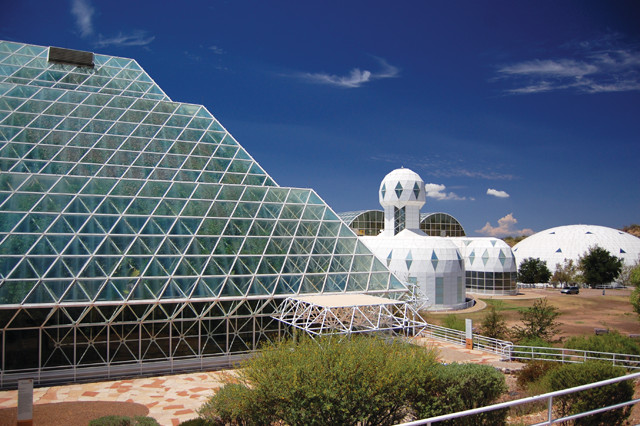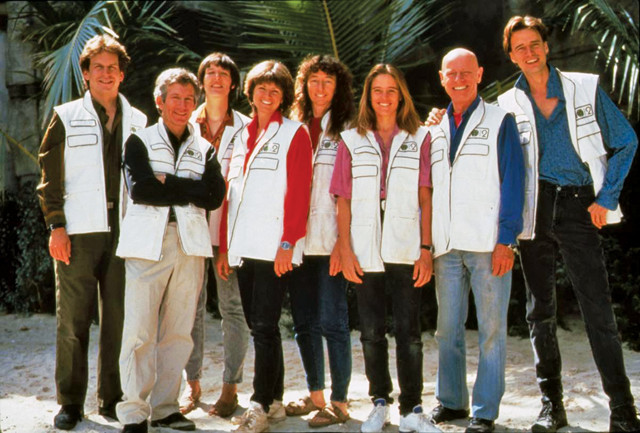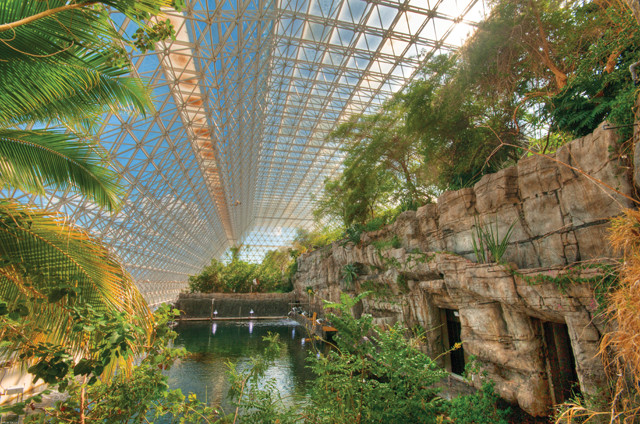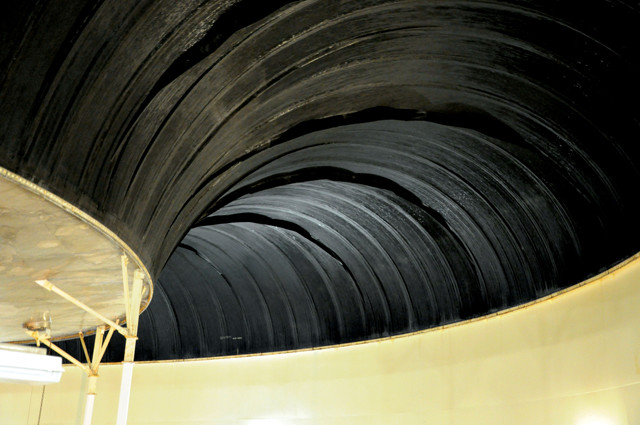
by Julia Rosen Tuesday, August 25, 2015

The Biosphere 2 facility was operated as a closed-ecosystem experiment from 1991 to 1993. Various universities have since used it as a research facility, including the University of Arizona, which now maintains it and offers public tours. Credit: ©Omar Bárcena, CC BY-NC 2.0.
It takes about an hour to drive from Tucson, Ariz., to the Biosphere 2 research facility, perched atop a plateau in the Santa Catalina Mountains. Through its glittering glass walls, you can still see the shadowy silhouette of the Brazilian rainforest that grows inside. Indeed, the facility once enclosed numerous small-scale experimental ecosystems — from a swath of swaying savanna to a 700,000-gallon ocean complete with its own coral reef. And, beginning on Sept. 26, 1991, Biosphere 2 enclosed a crew of four men and four women who would call the bubble home for two years.
The project was conceived by John P. Allen, a metallurgist, poet and co-founder of Space Biospheres Ventures, as a way to test possible technologies for colonizing Mars. A philanthropist named Ed Bass financed the operation, footing the estimated $150 million to $200 million bill for the building’s construction, which began in 1985. The team wanted to replicate the interconnected ecosystems of Earth — the first biosphere — in a life-size controlled laboratory called Biosphere 2. They hoped to launch a 100-year-long ecology experiment, and to see if this artificial environment could sustain human life. No one had ever built such a facility, and many scientists joined onto the project to help guide experiments.
Trouble ensued, however. One of the “biospherians,” Jane Poynter, had to leave the enclosure to seek medical attention and re-entered carrying a duffel bag (she maintains that it did not contain any vital supplies). The press also seized on revelations that drew into question the closed nature of the experiment. These included the fact that the crew survived partially on dried grains — instead of just the food they grew — and that, beginning 16 months into the experiment, managers pumped oxygen into Biosphere 2’s atmosphere to prevent concentrations of the gas from dipping to dangerously low levels. Public opinion took another dive after reports surfaced that some of the team had lived together on a commune and performed in a theater group together.
After the Scientific Advisory Committee resigned in 1993, citing frustration with the lack of progress and conflict with the facility’s management team, many observers denounced the project as a failure (the widely panned Pauly Shore movie, “Bio-Dome,” only added insult to injury).
Two decades later, with the benefit of hindsight, Biosphere 2’s problems, perceived to be catastrophic at the time, now appear more like the unanticipated setbacks of an ambitious experiment. Allen and members of the crew published dozens of papers on many facets of the now-famous experiment, from biological methods of recycling wastewater to the physiological effects of a reduced-calorie diet.
The facility remains an active research lab, used first by scientists affiliated with Columbia University, then with the University of Arizona. Now, the focus of most Biosphere 2 research has pivoted back to understanding Earth and the threats it faces from human activity and climate change.

On Sept. 26, 1991, eight crewmembers were sealed inside the facility to live for two years. Credit: University of Arizona.
Biosphere 2’s 1.27-hectare facility consists of one long wing, which, in its heyday, contained patches of rainforest, savanna, ocean, marsh, and desert ecosystems, together inhabited by 4,000 species ranging from primates to insects. A tunnel led to a futuristic facility that hosted the farm and so-called human habitat. Here, the crew slept, ate and grew 80 percent of their food, as well as the feed for their livestock, which included goats, chickens and pigs. Underneath it all lay a vast lair of machinery that kept the air circulating and water flowing. According to an account of the experiment by Rebecca Reider, biospherian Roy Walford called it “the Garden of Eden on top of an aircraft carrier.”
Like the future space bases it was designed to emulate, Biosphere 2 was materially closed and energetically open, meaning only light and heat could pass through its walls. It was, and remains, one of the most airtight structures ever built — leaking less than 10 percent of its atmosphere per year. To accommodate changes in the volume of air inside induced by daily swings in the temperature of the Arizona desert, designers gave Biosphere 2 a pair of artificial lungs that expanded and contracted to increase or decrease space.
From a scientific point of view, the first goal of locking a group of humans inside the bubble was just to see if the crew could survive. Taber MacCallum, another biospherian, who later married Jane Poynter, recalled in a New York Times documentary that, “most people on the Earth thought Biosphere 2 was going to turn to green slime in a matter of weeks.” That didn’t happen. In fact, Biosphere 2’s method of wastewater management, designed by biospherian Mark Nelson to combine anaerobic holding tanks with wetland bioremediation, successfully treated the water, which went back into the ecosystems, and eventually the food.
Another useful — if unplanned — outcome of the enclosure experiment were the results of a medical study conducted by Walford, a physician. Partly due to the low levels of light passing through the glass and partly due to cloudy weather related to the 1991–1992 El Niño, the farm yielded less food than expected, forcing participants onto a nutrient-dense, restricted-calorie diet. All the biospherians lost weight for the first eight months of the experiment, but remained remarkably healthy. Many indicators, including blood sugar and cholesterol, actually appeared to improve. By accident, the biospherians became the subjects of a major experiment on the health effects of caloric restriction, which some biologists think may extend life span.
However, the lack of food, on top of the isolated circumstances, had severe consequences for the team’s morale. Many suffered depression, and within six months, the group fractured into two factions that disagreed over whether to stick with the original plan or alter it to pursue more ambitious scientific goals. Eventually, the two sides stopped speaking altogether.
And Biosphere 2’s problems extended far beyond interpersonal strife. Many of the introduced animals and insects went extinct, leaving behind booming populations of opportunistic species like cockroaches and katydids. In particular, a kind of tramp ant, Paratrechina longicornis — called the “crazy ant” for its erratic behavior when stimulated — overran the facility, killing off the other ants, grasshoppers and crickets. Condensation produced too much rain in the desert and morning glories took over the rainforest. However, those issues paled in comparison to the changing atmosphere inside the dome.

Biosphere 2 hosts ocean, marsh, rainforest, savanna and desert biomes. Credit: ©Jasper Nance, CC BY-NC-ND 2.0.
The atmosphere inside Biosphere 2 started out with the same composition as the atmosphere on Earth, with roughly 21 percent oxygen. However, as the months passed, that number fell to 14 percent. Sixteen months into the experiment, it was as if the biospherians were living on a Himalayan peak; the lack of oxygen began to cause headaches and fatigue. When Walford, the physician, became so impaired that he could not complete a simple mathematical task, the project’s managers decided to pump oxygen into the dome, drawing the wrath of the media.
However, it took two geochemists from Columbia University, Wally Broecker and his graduate student Jeff Severinghaus (now a professor of paleoclimatology at Scripps Institution of Oceanography at the University of California at San Diego), to sleuth out where the oxygen had gone. They hypothesized that the problem began with the soil, which had been packed with compost and peat to boost food production. This ample organic matter fueled high rates of soil respiration, which produces carbon dioxide. In a normal ecosystem, much of this carbon would be recaptured during photosynthesis and stored in plants. However, Biosphere 2’s glass ceiling blocked more than half the incoming light, limiting productivity.
This imbalance caused carbon dioxide concentrations inside the dome to climb to between 2,000 and 4,000 parts per million — compared to about 350 parts per million in the outside air. Since two atoms of oxygen go into each molecule of carbon dioxide, this spike explained where some of the oxygen had gone. But not enough. Even after accounting for chemical scrubbers, which permanently removed carbon dioxide from Biosphere 2’s air in an effort to keep concentrations of the gas in check, scientists could only account for a fraction of the missing oxygen.
In fact, it turned out that there was a far more efficient carbon dioxide sink inside the building: its walls. The gas reacted with large areas of exposed concrete, converting it into carbonate and trapping the oxygen. After the enclosure experiment ended, Broecker and Severinghaus tested this hypothesis by taking core samples from inside and outside the building, and comparing them. As expected, the concrete from inside the dome showed much greater chemical changes that penetrated far deeper into the wall. Managers have since covered the building in a coating meant to limit this reaction.
Ironically, scientists only detected the missing oxygen — and the biospherians only suffered its effects — because of the facility’s tight seal. If its seams had leaked more, fresh air would have seeped inside. (A related, but opposite, problem occurred with nitrous oxide, which built up to dangerous levels because Biosphere 2’s ceiling blocked ultraviolet light, the main agent of nitrous oxide destruction in Earth’s atmosphere.) On the one hand, these complications marred the experiment. But, on the other, they represented challenges that future space bases might also encounter, argued Allen and other biospherians in a 2003 paper. Viewed in that light, Biosphere 2 functioned exactly as designed — as a test bed for grander things to come.

Two large rubber diaphragms inside the domes helped maintain air pressure inside the sealed facility during the 1991–1993 habitation experiment. Credit: ©John Kittelsrud, CC BY-NC-ND 2.0.
A decade later, space colonization remains a distant possibility, although Poynter and MacCallum are on deck to become the first humans to slingshot around the Red Planet as part of the Inspiration Mars project. As different institutions took over management of Biosphere 2, the research there shifted to understanding our own fast-changing planet.
In the late 1990s, scientists from Columbia University turned the high concentrations of carbon dioxide inside the dome to their advantage, as a way to assess what might lie in wait for Earth’s ecosystems as humans alter the composition of the atmosphere. Researchers grew poplars inside the dome and watched how they responded to the different atmosphere. They also studied the rainforest, to see if it grew faster or slower, or stored different amounts of carbon under higher levels of atmospheric carbon dioxide. Most famously, a team of scientists led by Chris Langdon, then at Columbia University, discovered that corals struggled to grow in the acidic waters of the facility’s miniature coral reef, sounding the alarm about the additional threat of ocean acidification.
When the University of Arizona took over in 2011, it rebranded the facility as B2 and launched a new series of global change experiments, including an initiative to study how landscapes evolve over time, and how climate change might alter them. The project features three slopes, each covered with a million kilograms of volcanic rock and sand that will develop into soil and eventually host plant life. Like many of the later works at B2, this research brings the controlled aspect of laboratory science to bear on the facility’s life-size models of Earth systems. To this day, there are few places like it.
Science like this isn’t as far removed from the original mission of Biosphere 2 as it might seem. While Allen and the biospherians may have had their eyes on the cosmos, their work helped demonstrate the difficulty of replicating an Earth-like human habitat, and the dangers of believing we have mastery over its ecosystems.
In a 1996 perspective paper, Joel Cohen of Rockefeller University and David Tilman of Columbia University reflected back on the legacy of Biosphere 2 and the lessons of the enclosure experiment. “At present, there is no demonstrated alternative to maintaining the viability of Earth,” they wrote. “Dismembering major biomes into small pieces, a consequence of widespread human activities, must be regarded with caution.”
© 2008-2021. All rights reserved. Any copying, redistribution or retransmission of any of the contents of this service without the expressed written permission of the American Geosciences Institute is expressly prohibited. Click here for all copyright requests.